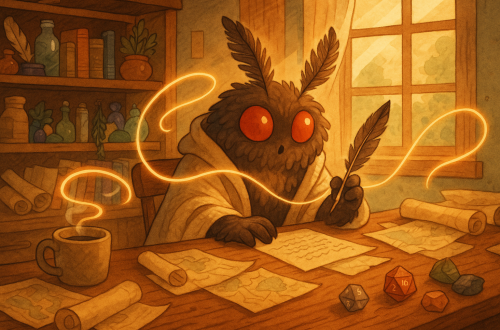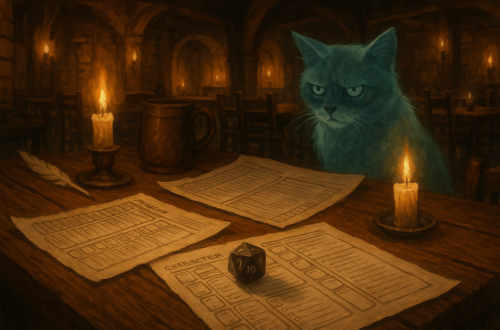Safety Tools in TTRPGs and Why They Make the Game Better for Everyone
Picture this: you’re deep in a dungeon, torch flickering, tension mounting. The rogue uncovers a dark secret—perhaps a cult, perhaps a betrayal, perhaps a mirror of something from real life that lands a little too hard. And suddenly, what was thrilling becomes… something else. The mood shifts. The table goes quiet. Not because the game is bad, but because no one knew the line until it was crossed.
This is where safety tools step in. Often misunderstood, occasionally maligned, they are not the sign of a fragile table. They are the quiet magic of a group that knows the difference between delicious dramatic tension and accidentally stepping on someone’s emotional landmine.
What Are Safety Tools?
Safety tools are simple mechanisms that help players steer around emotional discomfort during a game. They’re not about censorship. They’re about communication and consent, giving players the ability to say, “This isn’t working for me,” without derailing the story or putting anyone on the spot.
Some popular tools:
The X-Card
A literal or symbolic card a player can tap or raise if something crosses a line. No explanation needed. The scene shifts or rewinds, and play continues smoothly. For me, I will get nauseous if I am confronted with a graphic description of blood or gore. Literally, physically nauseous, and I have actually thrown up before because of it. I do need a way to tell a GM that they need to move on, preferably before I vomit on the whole table, and it’s not just because of my squishy feelings.
Lines and Veils
Lines are content that won’t appear in the game at all. Veils allow certain topics but keep them off-camera, fading to black rather than diving into detail. For instance, someone with arachnophobia might be fine with the mention of a giant spider, but not a detailed description. Players might be comfortable with sex scenes, but not in an overly descriptive way.
Stars and Wishes
A gentle debrief ritual after a session. Stars are things you loved. Wishes are things you’d like to see next time. It’s a way to guide the story toward everyone’s joy. Before you scoff and make a comment about participation medals, remember that this is a game, and it is collaborative. Calling it “stars and wishes” doesn’t change the fact that it is a gentle way to give feedback to the GM and to other players, while focusing on constructive criticism and continual improvement.
Script Change Tools
Like remote control buttons for the game. Pause to check in. Rewind to adjust something. Fast-forward if a scene is dragging into discomfort.
These aren’t constraints. They’re care. They let players lean into the emotional high-wire act with the comfort of a safety net.
When Are They Needed?
Every time you gather to play. Not every tool will be used every session, but their mere presence can shift the atmosphere from “survive the story” to “thrive in it.”
Even in lighthearted games, unexpected moments can arise. In horror campaigns, emotional roleplay, or dark themes, the need becomes even sharper. You cannot always know someone’s history, nor should you have to. Safety tools allow players to opt in or out of certain content on their own terms.
How to Choose and Use Them
Think of these tools as gear suited to your quest. A party venturing into cosmic horror might need a bigger toolkit than one attending goblin prom.
At Session Zero (you are having those, right?), talk about comfort levels and boundaries. Decide what tools to use. Revisit them if the tone shifts. Normalize using them. No side-eyes. No apologies. Just play.
Want minimal intrusion? Stars and Wishes might be enough. Planning emotional deep-dives or trauma-laced character arcs? Script Change and Lines & Veils might be your holy trinity.
Addressing the Skeptics
There’s always that one player. “Are we playing a game or holding a therapy session?” they say, arching an eyebrow like they’re trying to intimidate someone.
Ah, yes. The grumble. The skeptical eyebrow. “Back in my day, we played through our trauma and liked it!” someone says, clutching their 1980s dice bag.
To them, I say this: Safety tools are not therapy. They are not weakness. They are structure, scaffolding, trust.
Everyone loves a haunted house when they know where the exits are. This is the same. People are more willing to engage with risk when they know they can call timeout. It’s not about removing challenge—it’s about choosing it.
This doesn’t make the story less intense. It lets it be intense on purpose. That’s not fragility. That’s good design.
In Conclusion
I like to use Critical Role as an example for why trust and safety is so important. The fact that the players at the table are friends, they know each other, and they are not seeking to make anyone uncomfortable. That’s why the show is so successful and enjoyable, for both players and viewers.
Safety tools are not a sign that the table is soft. They’re a sign that the table is thoughtful.
They say, “We want you here, not just your character.” They say, “You matter.”
To the GM who encounters players who object to the use of safety tools, insist anyway. That player doesn’t have to use them, but their opinions don’t override the need for the rest of the party to feel safe. They also have the option to not participate if they think safety tools are a deal breaker.
Let me propose this: safety tools aren’t about coddling. They’re about consent. The difference between fear that excites and fear that harms is choice. We curate horror movies for our mood. We skip scenes in books. Why wouldn’t we grant players the same autonomy in a shared story?
And besides—do you really think a tool that lets people dive into intense themes on purpose, with full awareness of their own emotional boundaries, is weak? Or is it, perhaps, a more evolved kind of courage?
Real adventurers check for traps before opening the door.




